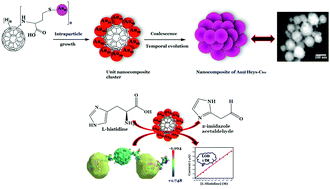Structure and dynamics of a dl-homocysteine functionalized fullerene-C60–gold nanocomposite: a femtomolar l-histidine sensor†
Abstract
A functionalized fullerene-C60-thiol mediated gold nanocomposite was realized using DL-homocysteine as a bifunctional ligand. The nanocomposite was designed by following electronic structure calculations via the DFT formalism. The computed electrostatic potential profile and the electronic HOMO–LUMO energy gap implied enhanced electron transport across the nanocomposite skeleton. Accordingly, synthesis of the nanocomposite proceeded with the hydrophilic fullerene-C60 thiol derivative via in situ reduction of gold(III), resulting in sterically full gold clusters bound to the fullerene-C60 core. Molecular dynamics simulations with the MM+ force field provided insight into the mode of interaction and direction of electron transfer in the nanocomposite–histidine ensemble. Subsequently, an electrochemical strategy for L-histidine sensing was proposed; the nanocomposite-modified glassy carbon electrode exhibited electrocatalytic activity towards L-histidine sensing, studied via cyclic and square wave voltammetry and impedance spectroscopy. A femtomolar L-histidine sensor, the first of its kind with orders of magnitude enhanced performance in its detection limit, linear range, sensitivity, stability and specificity, and free of interference, thus emerged.

- This article is part of the themed collection: Celebrating Excellence in Research: Women of Materials Science


 Please wait while we load your content...
Please wait while we load your content...